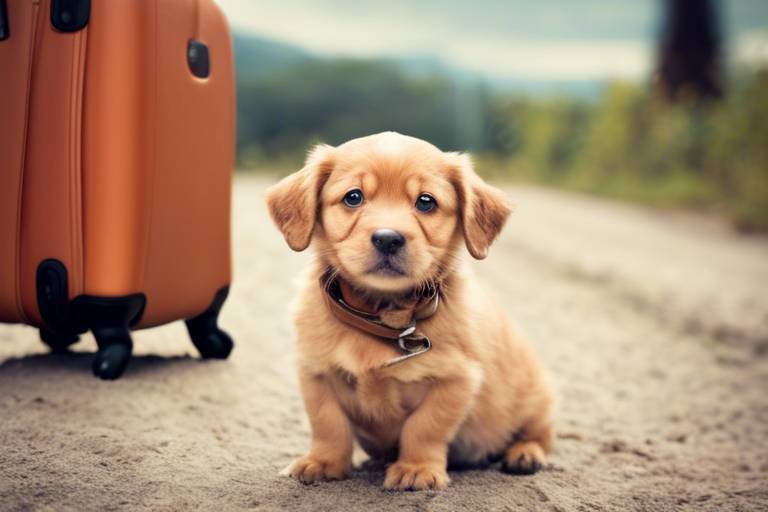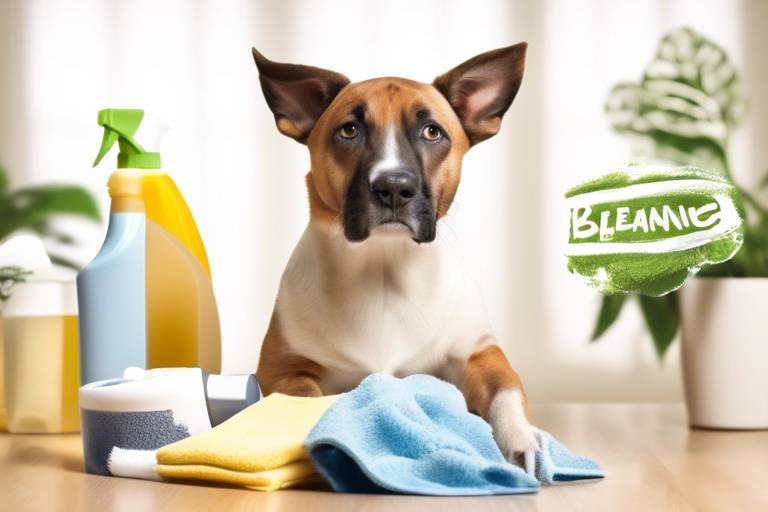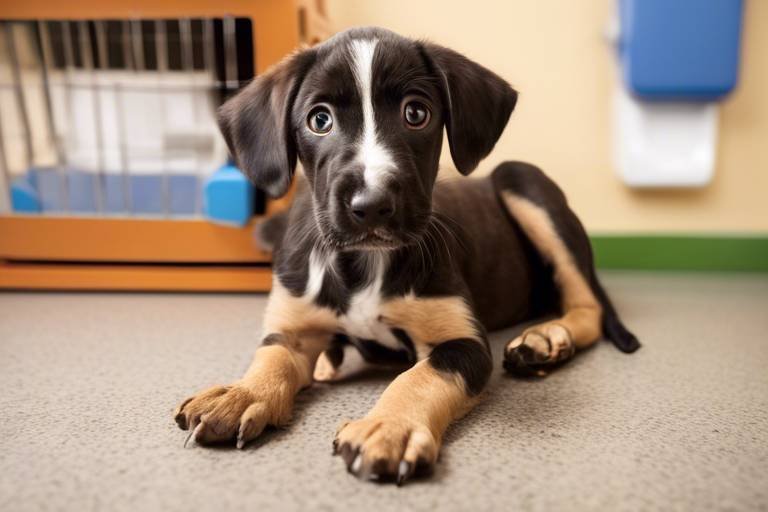Tips for Keeping Your Pet Safe While Traveling
Traveling with your furry friend can be an exhilarating adventure, but it also comes with its own set of challenges. Whether you're heading to the beach, embarking on a cross-country road trip, or flying to a distant destination, ensuring your pet's safety is paramount. Just like you wouldn't leave home without your wallet or keys, you shouldn't hit the road without a solid travel plan for your pet. In this article, we’ll dive into essential tips that will make your journey enjoyable and safe for both you and your beloved companion.
Before you pack your bags and hit the road, it's crucial to prepare your pet for the journey ahead. Think of this as a pre-trip checklist that ensures your furry friend is ready for whatever comes their way. Start with a visit to the veterinarian for a thorough health check. This is especially important if you're traveling long distances or crossing state lines, as certain areas may have specific health requirements. Make sure your pet is up to date on vaccinations and consider getting a health certificate, which can be a lifesaver in emergencies.
Don't forget to pack essentials for your pet! Just like you wouldn't leave home without your favorite snacks, your pet will need their own travel kit. Here’s a quick rundown of what to include:
- Food and water bowls
- Enough food for the trip
- Leash and harness
- Waste bags
- Comfort items like toys or blankets
By preparing ahead of time, you can help alleviate any stress or anxiety your pet may feel while traveling.
Choosing the right method of transportation is vital for your pet's comfort and safety. Each mode of travel has its own set of considerations, so let's break them down. If you're driving, ensure your vehicle is pet-friendly and safe. If you're flying, familiarize yourself with airline regulations regarding pet travel. Trains can also be a great option, but make sure to check their pet policies as well. Ultimately, the goal is to select a transportation method that minimizes stress for your furry friend while keeping them secure.
Traveling by car can be one of the most convenient ways to take your pet along for the ride. However, it’s important to implement safety measures to keep both you and your pet safe on the road. First and foremost, consider using pet restraints. These are essential for preventing distractions while driving. You can choose from a variety of restraints, including:
- Pet harnesses: These attach to your seatbelt and keep your pet secure.
- Crates or carriers: Ideal for smaller pets, providing a safe space during the ride.
Additionally, planning frequent pit stops is crucial for long car rides. Just as you would need breaks for bathroom needs and stretching your legs, your pet will need the same. Make sure to stop every couple of hours to let your pet relieve themselves, hydrate, and stretch their legs. This will not only keep your pet happy but also contribute to a more pleasant journey for you.
Air travel can be a bit more complicated when it comes to pets. Many airlines have specific regulations regarding pet travel, so it’s essential to do your homework beforehand. Start by checking the airline's pet policy and booking a pet-friendly flight. If your pet will be flying in the cargo hold, make sure they are crate trained. This will help them feel more comfortable and secure during the flight. Additionally, consider using calming aids or familiar toys to help minimize anxiety. A little preparation goes a long way in making air travel smoother for your furry friend.
Not all hotels roll out the welcome mat for pets, so finding pet-friendly accommodations is key to a successful trip. Start your search online, using websites that specialize in pet-friendly lodging. Read reviews and check for amenities that cater to pets, such as dog parks or pet-friendly rooms. Understanding each hotel's pet policies is also crucial. Some may have size restrictions, additional fees, or specific areas designated for pets. Knowing these details in advance can save you from unexpected surprises during your stay.
When researching hotels and rentals that accommodate pets, it’s essential to be thorough. Utilize online resources and don’t hesitate to call the property directly to ask questions. Look for places that not only allow pets but also offer a welcoming environment. Remember, a little research can lead to a much more enjoyable stay for both you and your pet.
Every accommodation has its own pet policies, and understanding these rules is vital. Some places may charge extra fees, while others may have restrictions on the number or size of pets allowed. Additionally, familiarize yourself with designated areas for pets, such as where they can relieve themselves or play. By being aware of these regulations, you can avoid potential issues and ensure a pleasant stay for everyone involved.
Q: Should I take my pet to the vet before traveling?
A: Yes! A health check and updated vaccinations are crucial for your pet's safety during travel.
Q: Can I bring my pet on a plane?
A: Most airlines allow pets, but it's important to check their specific regulations and book a pet-friendly flight.
Q: How do I find pet-friendly hotels?
A: Use online resources that specialize in pet-friendly accommodations and read reviews to find the best options.

Preparing Your Pet for Travel
When it comes to , the key is to ensure that both you and your furry friend are ready for the adventure ahead. Think of it as packing for a family vacation; you wouldn't forget your essentials, right? The same goes for your pet! Start with a visit to the veterinarian to get a thorough health check. This is crucial, especially if you're traveling long distances or crossing state lines. Your vet can provide valuable advice and ensure that your pet is up to date on vaccinations, which may be required depending on your destination.
Next, consider packing a travel kit for your pet. Just like you would prepare your suitcase, your pet needs their own set of essentials. Here’s a quick checklist of items to include in your pet's travel kit:
- Food and Water: Bring enough food for the duration of your trip, along with a portable water bowl to keep your pet hydrated.
- Medications: If your pet requires any medications, make sure to pack them along with instructions on how to administer them.
- Comfort Items: Bring along your pet’s favorite blanket or toy to help them feel secure and comfortable in unfamiliar surroundings.
- Identification: Ensure your pet has a collar with an ID tag that includes your contact information. Microchipping is also a great idea for added security.
Once you’ve checked off the essentials, it’s time to think about your pet’s comfort during the journey. Some pets experience anxiety while traveling, which can lead to a stressful situation for both of you. Consider using calming products like pheromone sprays or anxiety wraps to help soothe your pet. It’s also a good idea to take your pet on short car rides leading up to your trip, so they can get accustomed to being in a vehicle. This gradual exposure can significantly reduce their travel anxiety.
Finally, don’t forget to plan for your pet's bathroom breaks! Just like humans, pets need to relieve themselves, especially during long trips. Be sure to research pet-friendly rest stops along your route, or simply plan to stop every couple of hours. Not only will this keep your pet comfortable, but it also gives you a chance to stretch your legs and refresh before hitting the road again.
In summary, preparing your pet for travel involves a mix of health checks, packing the right essentials, and ensuring their comfort throughout the journey. With the right preparation, you can turn a potentially stressful experience into a delightful adventure for both you and your furry companion!

Choosing the Right Transportation
When it comes to traveling with your furry friend, choosing the right transportation method can make all the difference in ensuring a smooth and enjoyable journey. Whether you're hitting the open road, soaring through the skies, or hopping on a train, each mode of transport has its unique set of challenges and benefits. So, how do you decide what's best for your pet? Well, let's break it down!
First off, consider your pet's personality and comfort level. Some pets thrive in the car, enjoying the sights and smells of the journey, while others may find the confines of a crate during air travel stressful. If your pet is more anxious or has specific health needs, it might be wise to lean towards less stressful options. For instance, if you're planning a long road trip, a car might be the most convenient choice, allowing for flexibility in stops and breaks.
When traveling by car, safety should be your top priority. Make sure your pet is secure in the vehicle. This is where pet restraints come into play. They prevent your pet from roaming around the vehicle, which can be a significant distraction while driving. You can choose from various options, including:
- Pet harnesses: These attach to your car's seatbelt system, keeping your pet secure without the need for a crate.
- Pet carriers: Ideal for smaller pets, these can be placed on the seat or in the cargo area, ensuring your pet is contained and safe.
- Dog seat covers: While not a restraint, these can protect your car's interior and provide a comfortable surface for your pet during travel.
Now, if you're considering air travel, it's essential to familiarize yourself with airline regulations regarding pet travel. Each airline has its own rules about crate sizes, fees, and whether pets can travel in the cabin or must be checked as cargo. Preparing your pet for air travel can involve crate training, which ensures they feel comfortable and secure in their travel container.
Don't forget to think about your pet's comfort during the flight. You can help minimize anxiety by taking some simple steps:
- Familiarize your pet with their crate before the journey.
- Pack familiar items like their favorite blanket or toy to provide comfort.
- Consider speaking to your vet about calming medications if your pet is particularly anxious.
Lastly, if trains are your preferred mode of transport, check the specific pet policies of the train service you're using. Many train companies allow pets, but they may have restrictions on size and the type of carrier used. Always ensure your pet is comfortable, has enough space, and is secured to prevent any mishaps during the journey.
In conclusion, choosing the right transportation for your pet is about balancing safety, comfort, and convenience. By understanding your pet's needs and the specifics of each travel method, you can ensure a pleasant experience for both you and your furry companion. Happy travels!
Traveling by Car
Traveling by car can be an exhilarating adventure for both you and your furry companion. However, it’s crucial to take some safety measures to ensure a smooth ride. Imagine cruising down the highway with your pet happily enjoying the scenery outside the window—sounds delightful, right? But before you hit the road, let’s dive into some important tips to keep your pet safe and comfortable during your journey.
First and foremost, using pet restraints is essential. Just like you wouldn’t drive without a seatbelt, your pet needs to be secured as well. Pet restraints come in various forms, including harnesses, seat belts, and carriers. Each option has its benefits, and the right choice often depends on your pet’s size and temperament. For instance, a small dog might feel cozy in a carrier, while a larger breed might be better suited to a harness attached to the seatbelt. Here’s a quick breakdown of the options:
| Restraint Type | Best For | Benefits |
|---|---|---|
| Pet Harness | Medium to Large Dogs | Prevents distractions, keeps pet secure |
| Carriers | Small Dogs and Cats | Provides a safe space, easy to transport |
| Pet Seat Belts | All Sizes | Secures your pet in place, adjustable |
Next up, let’s talk about the importance of planning pit stops. Long car rides can be exhausting for pets, just as they are for us. To keep your pet happy and healthy, plan to take breaks every couple of hours. During these pit stops, allow your pet to stretch their legs, hydrate, and take care of their bathroom needs. It’s like a mini-vacation for them! Here are some things to consider during these breaks:
- Find a safe area away from traffic.
- Bring water and a portable bowl for hydration.
- Let your pet explore but keep them on a leash to ensure safety.
Lastly, keeping your pet’s comfort in mind is vital. Make sure the temperature inside the car is pleasant; pets can easily overheat. You might want to bring along their favorite blanket or toy to create a familiar environment. After all, a happy pet makes for a happy journey! Remember, before you embark on your trip, it’s always a good idea to consult with your veterinarian to ensure your pet is fit for travel. They can provide valuable advice on any potential health concerns or medications that may be needed during your trip.
In conclusion, traveling by car with your pet can be a fantastic experience if you prepare adequately. By using proper restraints, planning frequent stops, and ensuring your pet’s comfort, you can create a memorable road trip that both you and your furry friend will cherish. So buckle up, hit the road, and enjoy the adventure!
Using Pet Restraints
When it comes to traveling with your furry companion, safety is paramount. Just like we buckle up for a safe ride, your pet needs to be securely restrained to ensure both their well-being and your focus on the road. Pet restraints come in various forms, each designed to keep your pet safe while minimizing distractions. Imagine driving down the highway with your dog happily looking out the window, but suddenly they jump into your lap! Not only is that a recipe for disaster, but it can also lead to serious accidents.
One of the most popular options for pet restraints is the harness. Unlike traditional collars that can put pressure on your pet's neck, a harness distributes the force across their body, making it a safer choice for sudden stops or sharp turns. Plus, many harnesses are designed to attach directly to your car's seatbelt, providing an added layer of security. If your pet is a bit more on the adventurous side, consider using a pet seat belt. These are specially designed to clip onto your dog's harness and buckle into the seatbelt system of your car, allowing them to sit or lie down comfortably while staying secure.
For smaller pets, pet carriers are an excellent option. Not only do they keep your pet contained, but they also provide a cozy space where they can feel safe. When choosing a carrier, ensure it is well-ventilated and large enough for your pet to stand up, turn around, and lie down comfortably. Many carriers come with a safety strap that can be secured to the car's seatbelt, preventing any sudden movements during the journey.
To help you decide which restraint is best for your pet, here's a quick comparison table:
| Type of Restraint | Best For | Pros | Cons |
|---|---|---|---|
| Harness | Medium to large dogs | Comfortable, distributes force | Can be tricky to put on |
| Pet Seat Belt | All dog sizes | Easy to use, prevents distractions | May not fit all car models |
| Pet Carrier | Small dogs and cats | Safe and cozy | Limited space for movement |
Before you hit the road, it’s essential to train your pet to get used to their restraint. Start by allowing them to wear their harness or sit in their carrier at home for short periods. Gradually increase the time they spend in it, and reward them with treats to create a positive association. This way, when it’s time to travel, they won’t feel anxious or confined; instead, they'll view their restraint as a part of the adventure!
Remember, safety comes first. By choosing the right pet restraint and ensuring your furry friend is comfortable, you can enjoy a stress-free journey together. So buckle up, hit the road, and create unforgettable memories with your pet!
1. Is it legal to travel with an unrestrained pet in my car?
While laws vary by location, many places require pets to be restrained while traveling to prevent distractions. It's best to check local regulations to avoid fines.
2. What if my pet doesn't like their harness or carrier?
It's important to acclimate your pet to their restraint gradually. Use treats and positive reinforcement to help them associate the harness or carrier with good experiences.
3. Can I use a regular collar instead of a harness?
While a collar can be used for some pets, a harness is generally safer as it distributes pressure more evenly and reduces the risk of injury during sudden stops.
4. How do I choose the right size for a harness or carrier?
Measure your pet’s girth and weight, and refer to the manufacturer's sizing chart. A well-fitted harness or carrier should allow your pet to move comfortably without being too loose.
Planning Pit Stops
When embarking on a road trip with your beloved pet, one of the most critical aspects to consider is planning pit stops. Just like us, pets need breaks to stretch, relieve themselves, and hydrate. Imagine being cooped up in a car for hours on end—it's not just uncomfortable, it's downright stressful! So, how do you ensure your furry friend enjoys the ride as much as you do?
First and foremost, it’s essential to map out your journey ahead of time. Identify rest areas, parks, or pet-friendly spots along your route. This way, you won’t find yourself scrambling to locate a suitable place when your pet is signaling the need for a break. Having a plan can keep both your stress levels and your pet’s anxiety at bay.
Consider the following factors when planning your pit stops:
- Frequency: Depending on how long you’ll be driving, aim to stop every 2-3 hours. This allows your pet to stretch their legs and take care of business.
- Duration: Each stop should be long enough for your pet to relieve themselves, hydrate, and have a little exercise. A quick five-minute break might not cut it for an energetic pup!
- Safety: Always keep your pet on a leash during stops. Even if you think it’s a safe area, pets can easily get distracted and dart off.
Additionally, consider bringing along a portable water bowl and some snacks for your pet. Staying hydrated and having a little treat can make all the difference in keeping them content. You might even want to bring their favorite toy or blanket to provide comfort during these breaks.
Remember, the journey is just as important as the destination. By planning thoughtful pit stops, you can ensure that your pet remains happy and healthy throughout your travels. So, next time you hit the road, take a moment to think about your furry friend’s needs. After all, a well-rested pet is a happy pet!
Q: How often should I stop for my pet on a long drive?
A: It's generally recommended to stop every 2-3 hours to allow your pet to stretch, relieve themselves, and hydrate.
Q: What should I bring for my pet during pit stops?
A: Bring a portable water bowl, snacks, a leash, and any comfort items like toys or blankets to make your pet feel secure.
Q: Is it safe to let my pet off the leash during pit stops?
A: It's best to keep your pet on a leash during stops to prevent them from running off or getting into dangerous situations.
Traveling by Air
Air travel can be both exhilarating and daunting, especially when it involves our beloved furry companions. Imagine the thrill of jetting off to a new destination, but then picturing your pet feeling anxious in a cramped space. It’s essential to make this experience as smooth as possible for both you and your pet. First things first, check the airline regulations. Each airline has its own set of rules concerning pet travel, including size restrictions, crate specifications, and whether your pet can travel in the cabin or has to go in the cargo hold. Always verify these details before booking your tickets to avoid last-minute surprises.
Next, let’s talk about crate training. If your pet isn’t already accustomed to being in a crate, now is the time to start. Gradually introduce them to the crate by making it a cozy and inviting space. Place their favorite blanket, some toys, and maybe even a treat inside. This will help them associate the crate with positive experiences. Practice short stays in the crate at home, gradually increasing the duration to help your pet feel more comfortable.
Now, onto the flight itself. It’s crucial to minimize anxiety for your pet during the journey. Here are a few tips to help:
- Choose a direct flight whenever possible. This reduces the time your pet has to spend in transit and minimizes the chances of any unforeseen complications.
- Familiarize your pet with the crate before traveling. The more comfortable they are with their travel space, the less stressed they will be.
- Consider using calming products such as pheromone sprays or anxiety wraps. These can help soothe your pet during the flight.
Additionally, make sure to pack a travel bag for your pet. This should include essentials like food, water, a leash, and any medications they may need. Having these items on hand can make a world of difference. Remember, the key to a successful air travel experience is preparation. The more you plan, the smoother the journey will be for both you and your furry friend.
Q: Can I take my pet in the cabin with me?
A: It depends on the airline's policies. Many airlines allow small pets to travel in the cabin, but you must check the specific requirements and make a reservation in advance.
Q: What type of crate should I use for air travel?
A: Your pet's crate should be well-ventilated, secure, and large enough for them to stand, turn around, and lie down comfortably. Look for crates that meet the International Air Transport Association (IATA) guidelines.
Q: How can I help my pet feel more comfortable during the flight?
A: Familiarize your pet with the crate, use calming products, and ensure they have familiar items like toys or blankets. Keeping a routine with feeding and bathroom breaks can also help.

Finding Pet-Friendly Accommodations
When it comes to traveling with your furry companion, finding the right place to stay can be a game-changer. Not all hotels and rentals are created equal, and some may not welcome your pet with open arms. To ensure a comfortable and enjoyable stay for both you and your pet, it's essential to do your homework before booking your accommodations. Start by using reputable travel websites that allow you to filter your search for pet-friendly options. Websites like BringFido and Airbnb can be particularly helpful as they provide detailed listings and reviews from other pet owners.
Another tip is to read through the reviews of previous guests. Pay special attention to comments regarding the pet policies, as these can vary widely from one establishment to another. Some places may have size restrictions, while others may charge additional fees for pets. It's crucial to know what to expect to avoid any unpleasant surprises upon arrival. If possible, reach out directly to the hotel or rental owner to clarify any doubts about their pet policies. This proactive approach can save you time and stress later.
When searching for accommodations, consider the following factors:
- Location: Look for places that are close to parks or pet-friendly attractions. This will make it easier to take your pet for walks and enjoy the outdoors together.
- Size and Type of Accommodation: Depending on the size of your pet, you may want to choose a more spacious option like a vacation rental instead of a cramped hotel room.
- Amenities: Check if the accommodation offers pet-friendly amenities such as dog beds, bowls, or even pet-sitting services.
Once you've narrowed down your options, it’s a good idea to create a comparison table to evaluate the pros and cons of each place. Here’s a simple example:
| Accommodation | Pet Policy | Fees | Amenities |
|---|---|---|---|
| Hotel A | Dogs up to 50 lbs | $25 per night | Dog bed, bowls |
| Hotel B | All pets welcome | No fees | Pet sitting service |
| Rental C | Two pets max | $50 one-time fee | Fenced yard, dog park nearby |
By organizing your findings in this way, you can easily compare your options and make an informed decision. Remember, the goal is to create a stress-free environment for both you and your pet. After all, traveling should be a fun adventure, not a source of anxiety.
In conclusion, finding pet-friendly accommodations requires a bit of research, but the payoff is well worth it. By taking the time to understand each option and its policies, you can ensure a harmonious stay for you and your four-legged friend. So pack your bags, grab your pet, and get ready for an unforgettable journey together!
Q: How can I find pet-friendly hotels?
A: Use travel websites that specialize in pet-friendly accommodations, read reviews, and directly contact the hotels for specific policies.
Q: Are there usually extra fees for pets?
A: Yes, many hotels and rentals charge additional fees for pets. Make sure to check the pet policy before booking.
Q: What should I do if my pet has special needs?
A: Always inform the accommodation in advance about any special needs your pet may have, and ensure they can accommodate those requirements.
Researching Hotels and Rentals
When it comes to traveling with your furry companion, finding the right place to stay is crucial. Not all hotels and rentals are created equal, especially when it comes to pet policies. Imagine arriving at a beautiful hotel only to discover they don’t allow pets! To avoid this disappointment, it’s essential to do your homework ahead of time. Start by utilizing online resources that specialize in pet-friendly accommodations. Websites like BringFido and PetsWelcome can be lifesavers in your search. They offer comprehensive lists of hotels, vacation rentals, and even campgrounds that welcome pets.
While researching, make sure to read reviews from previous guests who traveled with their pets. Their experiences can provide valuable insights into how accommodating a place truly is. Look for comments on the cleanliness of pet-friendly rooms, the quality of amenities, and the overall atmosphere for pets. You might even find tips on nearby parks or pet-friendly restaurants that can make your stay even more enjoyable. Remember, a little research goes a long way in ensuring that both you and your pet have a comfortable stay.
Additionally, it’s important to understand the pet policies of each accommodation. Here are some key points to consider:
- Fees: Many hotels charge a non-refundable pet fee or a nightly rate for pets. Be sure to factor this into your budget.
- Size Restrictions: Some places have weight limits on pets, so if you have a larger breed, double-check before booking.
- Designated Areas: Some hotels may have specific areas where pets are allowed, such as certain floors or outdoor spaces.
In addition to these considerations, don’t hesitate to call the hotel directly. Speaking to a representative can clarify any doubts and help you get a feel for how pet-friendly they truly are. You can ask about their specific amenities for pets, such as dog parks, pet-sitting services, or even special treats at check-in. It’s like having a friendly chat with a neighbor who’s happy to help you find the best spot for your stay!
Lastly, don’t overlook vacation rentals. Platforms like Airbnb and Vrbo offer a myriad of options where you can filter for pet-friendly properties. Many hosts are more flexible than traditional hotels, allowing you to enjoy a home-like environment while keeping your pet comfortable. Just be sure to read the listing details carefully and communicate with the host about your pet’s needs.
Q: How can I ensure my pet is comfortable in a new environment?
A: Bring familiar items like their bed, toys, and food to make them feel at home.
Q: What should I do if my pet has special needs?
A: Always inform the hotel in advance about any special accommodations your pet may require.
Q: Are there any additional fees for pets in vacation rentals?
A: Yes, many vacation rentals charge a pet fee, so be sure to check the listing details.
Q: Can I leave my pet alone in the hotel room?
A: Policies vary by hotel, so it’s best to check with the front desk. Consider bringing a crate or pet-sitting service if needed.
Understanding Pet Policies
When it comes to traveling with your beloved pet, understanding the pet policies of your accommodations is absolutely essential. Each hotel or rental property has its own set of rules that can significantly impact your stay. Ignoring these guidelines can lead to unexpected fees or, worse, being turned away upon arrival. Imagine arriving at a beautiful hotel after a long journey, only to find out that your furry friend isn't welcome. That's a scenario no pet owner wants to encounter!
First and foremost, it’s important to check whether the establishment is pet-friendly. This might sound straightforward, but not all places that advertise themselves as such will accept pets of all sizes or breeds. Some accommodations might only allow small dogs or specific breeds, while others may have a weight limit. Always verify these details before making a reservation to avoid any surprises.
Next, take a closer look at the pet policies regarding fees. Many hotels charge a non-refundable pet fee or a nightly rate for pets, which can add up quickly. For example, a hotel might charge $50 for the first night and $25 for each additional night. Here’s a quick breakdown:
| Hotel Name | First Night Fee | Subsequent Night Fee |
|---|---|---|
| Cozy Inn | $50 | $25 |
| Pet Paradise | $75 | $30 |
| Furry Friends Hotel | $40 | $20 |
Additionally, some places may require a refundable deposit to cover any potential damages caused by your pet. This is especially common in vacation rentals where the property owner might be concerned about wear and tear. Make sure to read through the fine print regarding these deposits, as they can vary widely from one place to another.
Another crucial aspect to consider is the designated areas for pets. Most pet-friendly hotels will have specific zones where pets are allowed, such as certain floors, outdoor areas, or even designated pet parks. Familiarizing yourself with these areas can help you plan your pet’s needs better. After all, you want your pet to feel comfortable and have ample space to play and relieve themselves.
Lastly, don’t forget to check if there are any restrictions on the types of pets allowed. While dogs are the most common travel companions, some places may also accept cats, birds, or other small animals. It’s always wise to confirm this before packing your bags, especially if you have a less common pet.
In summary, understanding pet policies is not just about avoiding fines or penalties; it’s about ensuring a smooth and enjoyable experience for both you and your pet. By taking the time to research and clarify these policies, you can make your travel plans with confidence and peace of mind.
- What should I do if my pet is not allowed in a hotel? - Look for alternative accommodations that are pet-friendly or consider pet boarding services nearby.
- Are there any additional fees for pets? - Yes, many hotels charge extra fees for pets, including a one-time fee or a nightly rate.
- Can I leave my pet alone in the hotel room? - This depends on the hotel’s policy. Some allow it while others do not, so check beforehand.
Frequently Asked Questions
- What should I do to prepare my pet for travel?
Preparing your pet for travel involves several steps. Start with a visit to the vet to ensure your pet is healthy and up-to-date on vaccinations. Don't forget to pack essentials like food, water, medications, and a comfort item like their favorite toy or blanket. This way, your furry friend will feel more at home during the journey!
- Is it safe to travel with my pet in the car?
Absolutely! Traveling by car can be safe for your pet if you take the right precautions. Always use pet restraints such as harnesses or carriers to keep them secure. Make sure to plan for regular pit stops to let them stretch their legs and relieve themselves, ensuring a comfortable ride for everyone.
- What are the best practices for flying with my pet?
Flying with pets can be a bit tricky, but it’s manageable! First, check with your airline for their specific pet policies. Crate training your pet beforehand will help them feel more secure in their travel crate. During the flight, keep them calm with familiar items, and consider using calming products if your pet tends to get anxious.
- How can I find pet-friendly accommodations?
Finding pet-friendly accommodations is easier than you think! Use online resources like travel websites that filter results for pet-friendly options. Always read reviews to ensure the place is genuinely welcoming to pets, as some places might have hidden fees or restrictions.
- What should I know about pet policies at hotels?
Each hotel has its own pet policies, so it’s crucial to familiarize yourself with them before booking. Policies may include pet size restrictions, extra fees, and designated areas for pets. Understanding these rules can save you from unexpected surprises during your stay!


















